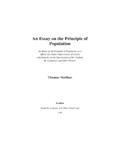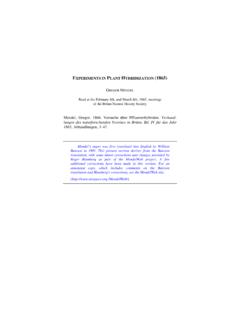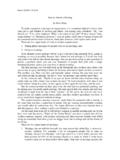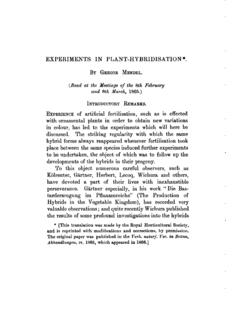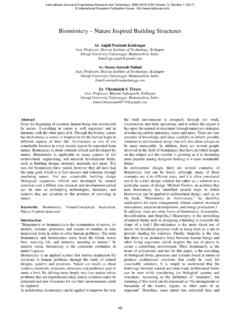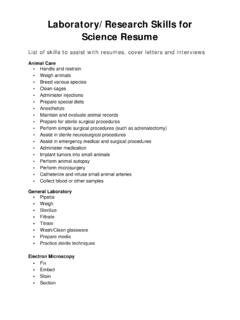Transcription of Molecular Biology Fundamentals - ESP
1 Molecular Biology : 1 File: N_drive:\jhu\class\1995\ 1994, 1995 Robert RobbinsMolecularBiologyFundamentalsRober t J. RobbinsJohns Hopkins Biology : 2 File: N_drive:\jhu\class\1995\ 1994, 1995 Robert RobbinsThe phenotype of an organism denotes its external appearance (size, color,intelligence, etc.). Classical genetics showed that genes control thetransmission of phenotype from one generation to the next. Biochemistryshowed that within one generation, proteins had a determining effect onphenotype. For many years, however, the relationship between genes andproteins was a mystery. Then, it was found that genes contain digitallyencoded instructions that direct the synthesis of proteins.
2 The crucial insightof Molecular Biology is that hereditary information is passed betweengenerations in a form that is truly, not metaphorically, how that digital code directs the creation of life is the goal ofmolecular of Molecular BiologyPhenotype Genes ProteinsClassical Genetics(1900s)Biochemistry(1900s)?Pheno type Genes ProteinsClassical Genetics(1900s)Biochemistry(1900s)Molecu larBiologyMolecular Biology : 3 File: N_drive:\jhu\class\1995\ 1994, 1995 Robert RobbinsClassical GeneticsRegular numerical patterns of inheritance showed that the passage oftraits from one generation to the next could be explained with theassumption that hypothetical particles, or genes, were carried in pairsin adults, but transmitted individually to Genes ProteinsClassical Genetics(1900s) Molecular Biology : 4 File: N_drive.
3 \jhu\class\1995\ 1994, 1995 Robert RobbinsClassical GeneticsDuring the first half of this century, classical investigation of thegene established that theoretical objects called genes were thefundamental units of heredity. According to the classical model ofthe gene:Genes behave in inheritance as independent are carried in a linear arrangement in the chromosome,where they occupy stable recombine as discrete can mutate to stable new , genes seemed to be particulate objects, arranged on thechromosome like beads on a string. The genes are arranged in a manner similar to beads strung on aloose , , and Beadle, , 1939. An Introduction toGenetics. W. B. Saunders Company, Philadelphia, p.
4 Biology : 5 File: N_drive:\jhu\class\1995\ 1994, 1995 Robert RobbinsMapping involves placing the beads in the correct order andassigning a correct address to each bead. The address assigned to abead is its beads can be conceptually separated from the string, which has addresses that are independent of the GeneticsMolecular Biology : 6 File: N_drive:\jhu\class\1995\ 1994, 1995 Robert RobbinsIn this model, genes are independent, mutually exclusive, non-overlapping entities, each with its own absolute that the beads have width, mapping could be extendedto assigning a pair of numbers to each bead so that a locus is definedas a region, not a GeneticsMolecular Biology : 7 File: N_drive:\jhu\class\1995\ 1994, 1995 Robert RobbinsAnd, in fact, the first genetic map ever published was of just thattype.
5 Sturtevant, , 1913, The linear arrangement of six sex-linked factors in Drosophila as shown by their mode of association,Journal of Experimental Zoology, 14 = yellow bodyC = white eyeO = eosin eyeP = vermilion eyeR = rudimentary wingM = miniature wingDrosophila melanogasterIn principle, maps of a few genes might be represented by showingthe gene names in order, with their relative positions GeneticsMolecular Biology : 8 File: N_drive:\jhu\class\1995\ 1994, 1995 Robert RobbinsBiochemistryThe aim of modern Biology is to interpret the properties of theorganism by the structure of its constituent , F. 1973. The Logic of Life. New York: Pantheon the Molecular basis of life had its beginnings withthe advent of biochemistry.
6 Early in the nineteenth century, it wasdiscovered that preparations of fibrous material could be obtainedfrom cell extracts of plants and animals. Mulder concluded in 1838that this material was:Later, many wondered whether chemical processes in living systemsobeyed the same laws as did chemistry elsewhere. Complex carbon-based compounds were readily synthesized in cells, but seemedimpossible to construct in the the beginning of the twentieth century, chemists had been able tosynthesize a few organic compounds, and, more importantly, todemonstrate that complex organic reactions could be accomplishedin non-living cellular extracts. These reactions were found to becatalyzed by a class of proteins called biochemistry, then, was characterized by (1) efforts tounderstand the structure and chemistry of proteins themselves, and(2) efforts to discover, catalog, and understand enzymaticallycatalayzed biochemical doubt the most important of the known componentsof living matter, and it would appear that without life wouldnot be possible.
7 This substance has been named Genes ProteinsBiochemistry(1900s) Molecular Biology : 9 File: N_drive:\jhu\class\1995\ 1994, 1995 Robert RobbinsIf the genes are conceived as chemicalsubstances, only one class of compounds needbe given to which they can be reckoned asbelonging, and that is the proteins in the widersense, on account of the inexhaustiblepossibilities for variation which they offer..Such being the case, the most likely role forthe nucleic acids seems to be that of thestructure-determining supporting Caspersson. 1936. ber den chemischen Aufbau derStrukturen des Zellkernes. Acta Med. Skand., 73, , FallaciesAt any given time in a particular science, there will be beliefs that are heldso strongly that they are considered beyond challenge, yet they will proveto be wildly wrong.
8 This poses a great challenge for the design ofscientific databases, which must reflect current beliefs in the field, yet berobust in the face of changes in fundamental concepts or Molecular Biology began, biochemists believed that DNA wascomposed of a monotonous rotation of four basic components, thenucleotides adenine, cytosine, guanine, and thymine. Since a repeatingpolymer consisting of four subunits could not encode information, it waswidely held that DNA provided only a structural role in chromosomes andthat genetic information was stored in Biology : 10 File: N_drive:\jhu\class\1995\ 1994, 1995 Robert RobbinsMolecular BiologyKey Discoveries:1928 Heritable changes can be transmitted frombacterium to bacterium through a chemicalextract (the transforming factor) takenfrom other The transforming factor appears to be The tetranucleotide hypothesis of DNAstructure is The structure of DNA is established to be adouble is constructed as a double-stranded molecule, with absolutely noconstraints upon the liner order of subcomponents along each strand, butwith the pairing between strands totally constrained according tocomplementarity rules: A always pairs with T and C always pairs with Genes ProteinsClassical Genetics(1900s)Biochemistry(1900s)Molecu larBiologyMolecular Biology : 11 File: N_drive.
9 \jhu\class\1995\ 1994, 1995 Robert RobbinsrRNADNAmRNAtRNAP roteinThe Fundamental DogmaInformation coded in DNA (deoxyribonucleic acid) directs the synthesisof different RNA (ribonucleic acid) molecules. RNA molecules fall intoseveral different categories:Both rRNA and tRNA are generic groups of molecules in that all types ofrRNA and all types of tRNA are involved in the synthesis of every type ofprotein. However, mRNA is specific in that a different type of mRNA isrequired for every different type of :ribosomal RNA that is required for building ribosomes, whichare structures necessary for protein :transfer RNA that serves to transfer individual amino acidmolecules from the general cytoplasm to their appropriatelocation in a growing polypeptide during protein :messenger RNA that carries the specific instructions for buildinga specific whole system is recursive, in that certain proteins are required for thesynthesis of RNAs, as well as for the synthesis of DNA Biology : 12 File: N_drive.
10 \jhu\class\1995\ 1994, 1995 Robert RobbinsP1T1 TranscriptionPost-transcriptional modificationTranslationPost-translationa l modificationSelf-assembly to final proteinmRNA:Primary Transcript:Polypeptide:Modified Polypeptide:DNA:gene 1 Some post-transcriptional processing of the immediate RNA transcript isnecessary to produce a finished RNA, and post-translational processing ofpolypeptides can be needed to produce a final directs protein synthesis through a multi-step process. First, DNAis copied to mRNA through the process of transcription. The rulesgoverning transcription are the same as the rules govering the interstrandconstraint in DNA. Then translation produces a polypeptide with anamino-acid sequence that is completely specified by the sequence ofnucleotides in the RNA.
